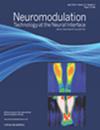Accelerated Transcutaneous Auricular Vagus Nerve Stimulation for Inpatient Depression and Anxiety: The iWAVE Open Label Pilot Trial
IF 3.2
3区 医学
Q2 CLINICAL NEUROLOGY
引用次数: 0
Abstract
Introduction
Brain stimulation is not a common inpatient psychiatric treatment; however, there are an increasing number of neuromodulation treatments approved for psychiatric indications. Noninvasive techniques, such as transcutaneous auricular vagus nerve stimulation (taVNS), are promising and should be investigated in this novel setting. This study evaluates the safety and feasibility of taVNS on the inpatient psychiatric unit and preliminarily explores efficacy for comorbid depression and anxiety.
Materials and Methods
Ten adult patients (five women, mean age ± SD, 35.60 ± 19.14 years) admitted to the inpatient psychiatric unit with comorbid depression and anxiety participated in this open-label safety and feasibility trial. Patients were randomized to receive one of two taVNS dosing approaches: 1) three taVNS sessions on three consecutive days (nine sessions total) (n = 5) or 2) nine taVNS sessions in one day (n = 5). Each day, we assessed depression, using the Patient Health Questionnaire (PHQ-9) and Beck Depression Inventory (BDI), and anxiety, using the Generalized Anxiety Disorder-7 (GAD-7) and Beck Anxiety Inventory (BAI).
Results
Both taVNS dosing approaches were safe and feasible in this novel setting. There were no serious adverse events, and we observed a low rate of minor adverse effects, which was similar across treatment conditions. Regardless of condition, stimulation significantly reduced GAD-7 (mean reduction ± SD, −5.90 to 6.87, p < 0.05), BAI (−9.40 ± 10.52, p < 0.05), PHQ-9 (−6.00 ± 7.57, p < 0.05), and BDI (−11.00 ± 11.59, p < 0.05) final scores compared with baseline. There was not a significant difference in clinical response between treatment conditions.
Discussion
In this open label study, taVNS significantly decreased depression and anxiety symptoms in patients admitted to the inpatient unit. The small sample size in this trial limited our ability to characterize patient characteristics that may drive response. However, our results suggest taVNS may be an effective adjunct to inpatient psychiatric treatment and should continue to be studied in this setting.
Clinical Trial Registration
The Clinicaltrials.gov registration number for the study is NCT05791383.
加速经皮耳迷走神经刺激治疗住院患者抑郁和焦虑:iWAVE开放标签试点试验
脑刺激不是一种常见的住院精神病治疗;然而,越来越多的神经调节疗法被批准用于精神适应症。无创技术,如经皮耳迷走神经刺激(taVNS),是很有前途的,应该在这种新的环境下进行研究。本研究评价了taVNS在精神科住院病人中的安全性和可行性,并初步探讨了taVNS对共病性抑郁和焦虑的疗效。材料与方法:10例精神科住院合并抑郁、焦虑的成人患者(女性5例,平均年龄±SD, 35.60±19.14岁)参加本开放标签安全性与可行性试验。患者随机接受两种taVNS给药方法中的一种:1)连续三天进行三次taVNS治疗(共九次)(n = 5)或2)一天进行九次taVNS治疗(n = 5)。每天,我们使用患者健康问卷(PHQ-9)和贝克抑郁量表(BDI)评估抑郁,使用广泛性焦虑障碍-7 (GAD-7)和贝克焦虑量表(BAI)评估焦虑。结果:两种taVNS给药方法在这种新环境下都是安全可行的。没有严重的不良事件,我们观察到轻微不良反应的发生率很低,这在不同的治疗条件下是相似的。无论在何种情况下,与基线相比,刺激均显著降低GAD-7(平均降低±SD, -5.90至6.87,p < 0.05)、BAI(-9.40±10.52,p < 0.05)、PHQ-9(-6.00±7.57,p < 0.05)和BDI(-11.00±11.59,p < 0.05)最终得分。不同治疗条件下的临床反应无显著差异。讨论:在这项开放标签研究中,taVNS显著降低住院患者的抑郁和焦虑症状。该试验的小样本量限制了我们描述可能驱动反应的患者特征的能力。然而,我们的研究结果表明,taVNS可能是住院精神病治疗的有效辅助手段,应该在这种情况下继续研究。临床试验注册:该研究的Clinicaltrials.gov注册号为NCT05791383。
本文章由计算机程序翻译,如有差异,请以英文原文为准。
求助全文
约1分钟内获得全文
求助全文
来源期刊

Neuromodulation
医学-临床神经学
CiteScore
6.40
自引率
3.60%
发文量
978
审稿时长
54 days
期刊介绍:
Neuromodulation: Technology at the Neural Interface is the preeminent journal in the area of neuromodulation, providing our readership with the state of the art clinical, translational, and basic science research in the field. For clinicians, engineers, scientists and members of the biotechnology industry alike, Neuromodulation provides timely and rigorously peer-reviewed articles on the technology, science, and clinical application of devices that interface with the nervous system to treat disease and improve function.
 求助内容:
求助内容: 应助结果提醒方式:
应助结果提醒方式:


